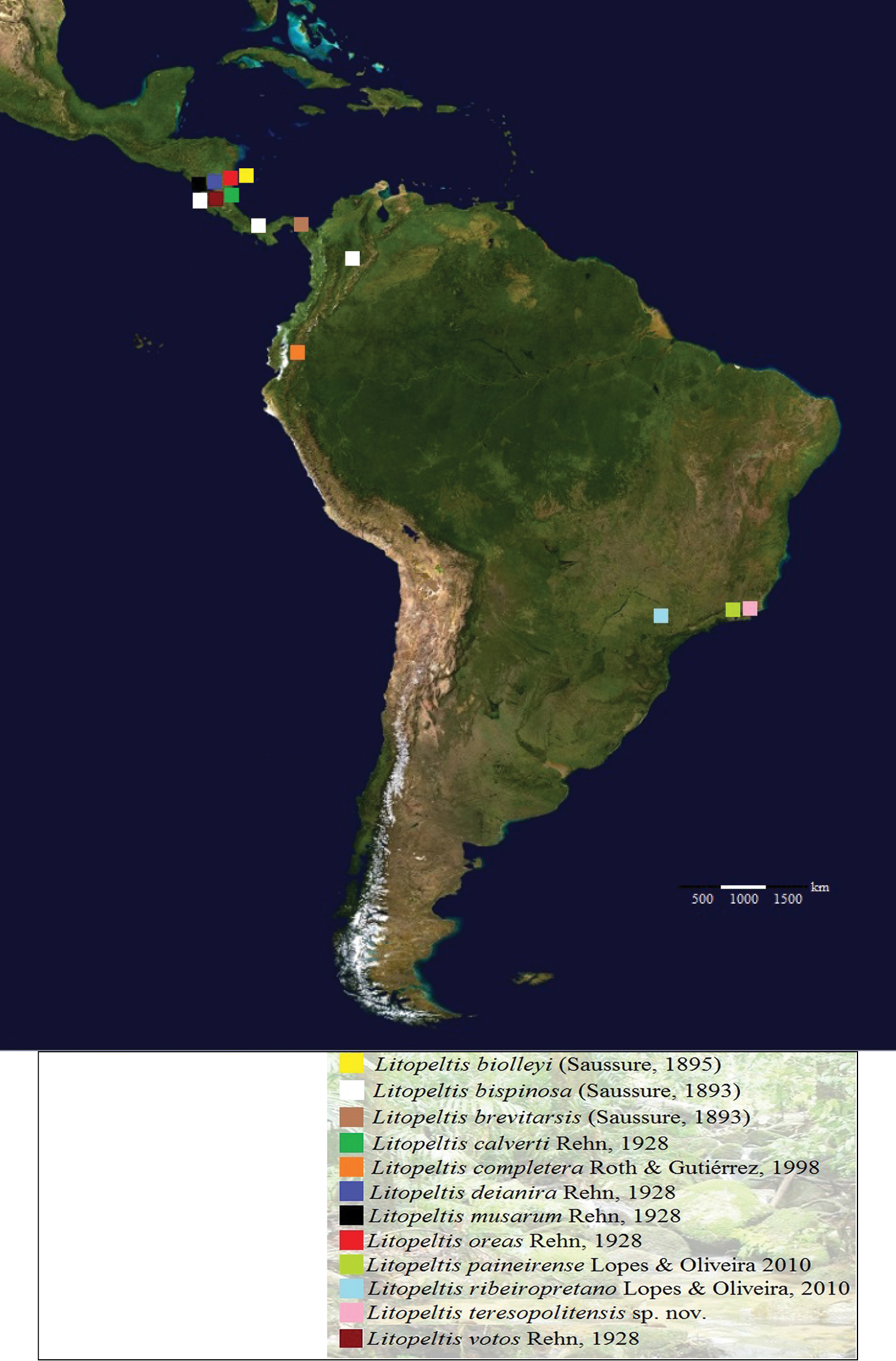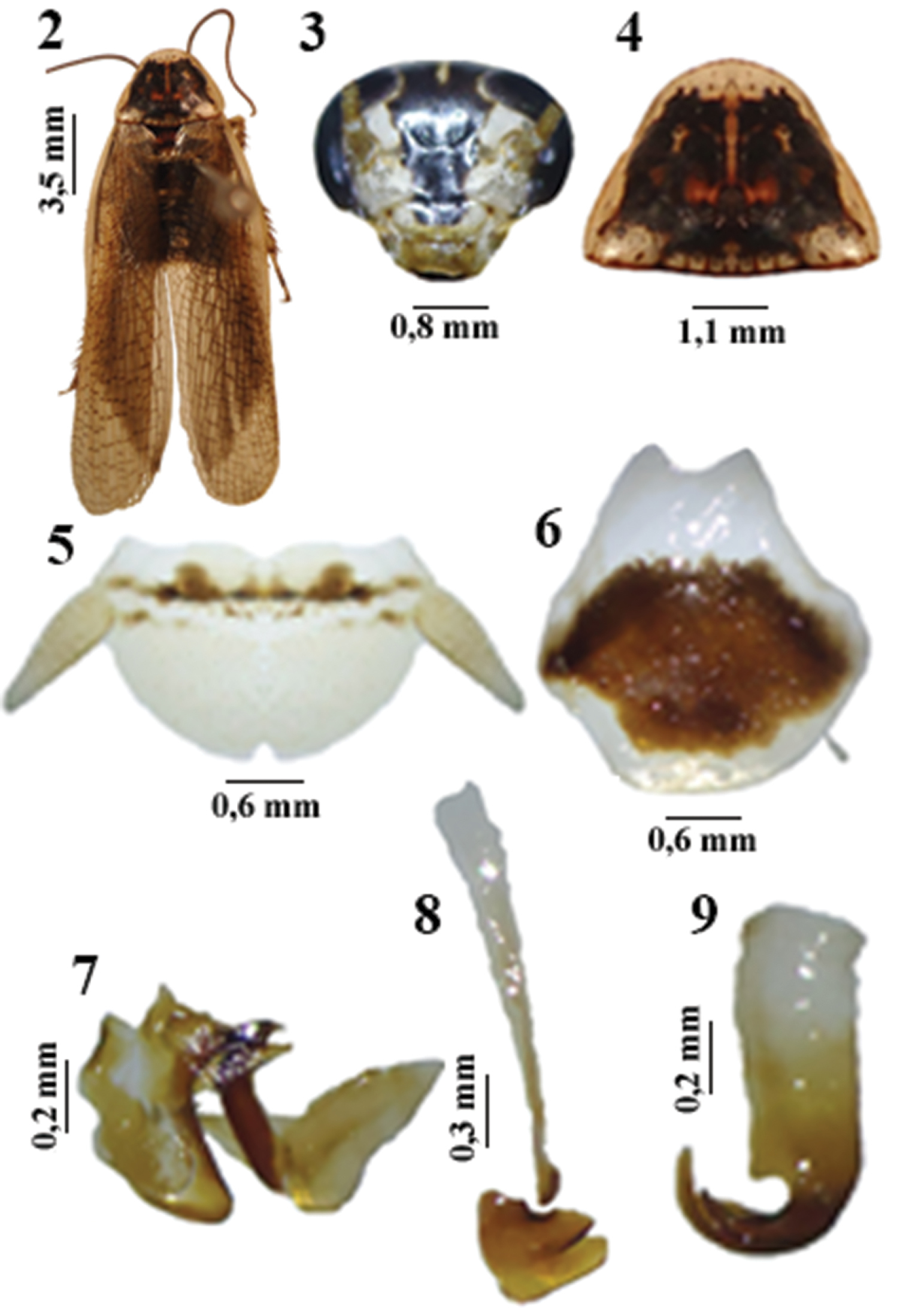






Citation: Silva LOC, Lopes SM (2014) A new species of Litopeltis Hebard, 1920 from Rio de Janeiro, Brazil (Blattodea, Blaberidae, Epilamprinae) with a key to males and geographical distribution of the remaining species of the genus. ZooKeys 420: 41–49. doi: 10.3897/zookeys.420.7555
This contribution describes a new species of Litopeltis from Brazil, L. teresopolitensis sp. n., which shows similarities with L. paineirensis Lopes & Oliveira, 2010 and L. ribeiropretano Lopes & Oliveira, 2010. It differs in characters of morphology genitalia and configuration, with the median sclerite bearing microspines on the sclerotic apex. A map showing the geographic distribution of the Brazilian species and a key to males of the other species of the genus are also presented.
Blaberidae, key, Litopeltis, Morphology, new species, taxonomy
The genus Litopeltis was described by
Map of geographical distribution of Litopeltis Hebard, 1920.
The present contribution provides information about the genus Litopeltis, including a key, and a description of a new species. The habitus, head, pronotum and external and internal genitalia with of the holotypes of the Brazilian species and new species were compared, the original descriptions were studied.
The genital plates were removed after dissection of the posterior part of the abdomen, using traditional dissection techniques, as described by Lopes and Oliveira (2000). After analysis, the genital plates and genital pieces were stored in microtubes containing glycerin and attached to the respective exemplar, a technique developed by
Holotype ♂, BRAZIL: Rio de Janeiro, Teresópolis, Parque do Ingá District, III/2013, Schilithz, A. G. col.
The name is given for Teresópolis, the collection locality of the holotype.
Dimensions (mm): Male holotype, total length: 20.7; length of pronotum: 4.0; width of pronotum: 4.5; length of tegmen: 17.5; width of tegmen: 4.4.
Male holotype. Coloration. General coloring chestnut (Fig. 2). Head with dark eyes, vertex dark with a white vertical line and interocular space in center of the forehead and center of clypeus black (Fig. 3); antennae opaque, first 26 antennomeres glossy, remainder tomentose. Central disk of pronotum with black spots (Fig. 4). Legs with bases of coxae black, spines on tibiaes, dorsal part of tarsus and claws brown, remaining segments of legs, pulvilli and arolium white. Tegmen hyaline, wings with brown veins. Abdomen with dark-brown segments and whitish-yellow lateral margins.
Litopeltis teresopolitensis sp. n., male 2 habitus (dorsal view) 3 head (ventral view) 4 pronotum (dorsal view) 5 supra-anal plate (dorsal view) 6 subgenital plate (ventral view) 7 left phallomere (dorsal view) 8 median sclerite (dorsal view) 9 right phallomere (dorsal view).
Head. Vertex hidden; interocular space ample, subequal to distance between bases of antennal insertions. Antennae tomentose distally, reaching slightly over half of length of abdomen. Ocelli developed. Maxillar palpi tomentose.
Thorax. Pronotum transverse, trapezoid, convex with rounded apex and slightly sinuous base. Legs short and robust. Femur I, anteroventral margin bearing three spines in basal half, a row of 21 spines and one longer apical spine in apical half, with a large robust spine on apex; posteroventral margin with row of seven slender spines, ending with two robust spines in apical third. Femur II, anteroventral margin bearing two robust spines, one median, the other apical; posteroventral margin with three to four robust spines. Femur III, antero- and posteroventral margin with two to three robust spines. Large pulvilli present on all tarsomeres; arolia present; claws symmetrical with slight specialization, having eight small rectangular structures.
Wings. Tegmina long, overreaching apex of cerci; marginal field concave and well delineated; scapular field long and narrow with apically oblique arrangement of veins; discoidal field ample and convex, apically widened with a longitudinal arrangement of veins; anal field ample, elongated, with three axillary veins. Hind wings with costal sector having the apices of the veins dilated; apical triangle present; anal field folded fanwise.
Abdomen. Absence of tergal modifications. Supra-anal plate short and wide, with smooth median apical indentation; cerci short (Fig. 5). Subgenital plate widened and prominent medially, with acute styli in median apical region of plate (Fig. 6). Left phallomere with median sclerotic structure in shape of an inverted “V” (Fig. 7); median sclerite developed, with microspines on sclerotized apex (Fig. 8); right phallomere hook-shaped (Fig. 9).
This species appears to be to Litopeltis paineirensis Lopes & Oliveira, 2010 (Figs 10–17), which it resembles in the median sclerite (Fig. 16) and the subgenital plate (Fig. 14); and to Litopeltis ribeiropretano Lopes & Oliveira, 2010 (Figs 18–25), which has a similar right phallomere (Fig. 25).
Litopeltis paineirensis Lopes & Oliveira, 2010, male. 10 habitus (dorsal view) 11 head (ventral view) 12 Pronotum (dorsal view) 13 supra-anal plate (dorsal view) 14 subgenital plate (ventral view) 15 left phallomere (dorsal view) 16 median sclerite (dorsal view) 17 right phallomere (dorsal view)
Litopeltis ribeiropretano Lopes & Oliveira, 2010, male. 18 habitus (dorsal view) 19 head (ventral view) 20 pronotum (dorsal view) 21 supra-anal plate (dorsal view) 22 subgenital plate (ventral view) 23 left phallomere (dorsal view) 24 median sclerite (dorsal view) 25 right phallomere (dorsal view)
The species Litopeltis brevitarsis (Saussure, 1893), Litopeltis compleptera Roth & Gutierrez, 1998 and Litopeltis musarum Rehn, 1928 were not included in the key because they were described from females.
| 1 | Neotropical species endemic to Brazil | 2 |
| – | Neotropical species, however occurring outside of Brazil | 4 |
| 2 | Central disk with nonuniforme spots on pronotum; apex of median sclerite without spike like protuberances (Figs 4, 8, 12 and 16) | 3 |
| – | Central disk with uniforme spots on pronotum; apex of median sclerite with spike-like protuberances (Figs 20 and 24) | Litopeltis ribeiropretano |
| 3 | Right phallomere abruptly tapering pre-apically (Fig. 9) | Litopeltis teresopolitensis sp. n. |
| – | Right phallomere only slightly tapering pre-apically (Fig. 17) | Litopeltis paineirensis |
| 4 | Total length larger than 15, 6 mm | 5 |
| – | Total length less than or equal to 15, 6 mm | 6 |
| 5 | Dorsal sclerite from median sclerite rounded in the apex and developed, almost reaching the prepuce extension | Litopeltis bispinosa (Saussure, 1893) (Figs 39a–41 in Roth 1971) |
| – | Dorsal sclerite from median sclerite, reduced and thin in the apex, not reaching all prepuce extension | Litopeltis biolleyi (Saussure, 1895) (Figs 42–44 in Roth 1971) |
| 6 | Dorsal sclerite from median sclerite foliaceous, not reaching the middle of prepuce | Litopeltis oreas Rehn, 1928 (Figs 45–47 in Roth 1971) |
| – | Dorsal sclerite from median sclerite not foliaceous | 7 |
| 7 | Length of pronotum less than or equal to 4, 8 mm | Litopeltis votos Rehn, 1928 |
| – | Length of pronotum longer than 4, 8 mm | 8 |
| 8 | Width of tegmen less than or equal to 6, 2 mm | Litopeltis deianira Rehn, 1928 |
| – | Width of tegmen longer than 6, 2 mm | Litopeltis calverti Rehn, 1938 |



